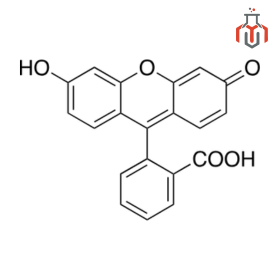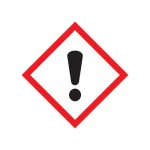

Fluorescein, also known as Uranine or Acid Yellow 73, is a synthetic dye belonging to the xanthene dye family. It was first synthesized in 1871 by Von Baeyer, from two petroleum products, resorcinol and phthalic anhydride. It appears as a yellow amorphous solid or orange-red crystal, emitting bright green fluorescence when exposed to light of a specific wavelength. It is used as a fluorescent tracer in many applications, including corneal injuries and trauma.

CAS No.: 2321-0705
Synonyms: Solvent Yellow 94, D&C Yellow no. 8, 3′,6′-dihydroxyspiro[2-benzofuran-3,9′-xanthene]-1-one, Yellow fluorescein, Hydroxyfluorone, Uranine, Soap Yellow
Resources: Biological Stains | Classification, Examples & Uses
| Physical Properties | |
| Chemical formula | C20H12O5 |
| IUPAC name | 3′,6′-dihydroxyspiro[2-benzofuran-3,9′-xanthene]-1-one |
| Molecular weight | 332.3 g/mol |
| Solubility | Dilute aqueous bases like ethanol,acetone and DMSO |
| Insoluble | In water |
| Odor | Odorless |
| Density | ~ 1.59 g/cm³ |
| Chemical Properties | |
| Color | Orange-red |
| State | Crystal or powder |
| Color Index | 45350 |
| Refractive index | 1.5 |
| pKa | 6.4 |
| Storage | Room temp. |
| λmax | 493.5nm, 496nm, 469nm, 515nm |
In Medical and Ophthalmic Applications
In Diagnostics and Bio-imaging
In Scientific and Research Applications
In Chemical and Environmental Applications
In Industrial, Forensic, and Consumer Applications
| Pictograms : |  |
| Hazard Statements : | H319: Causes serious eye irritation. |
| Precautionary statements : | P280: Wear protective gloves, protective clothing, and eye protection. P264: Wash hands thoroughly after handling. P305 + P351 + P338: IF IN EYES: Rinse cautiously with water for several minutes. Remove contact lenses if present and easy to do. Continue rinsing. P501: Dispose of contents/container by local regulations. |
Fluorescein, also known as Uranine or Acid Yellow 73, is a synthetic dye belonging to the xanthene dye family. It was first synthesized in 1871 by Von Baeyer, from two petroleum products, resorcinol and phthalic anhydride. It appears as a yellow amorphous solid or orange-red crystal, emitting bright green fluorescence when exposed to light of a specific wavelength. It is used as a fluorescent tracer in many applications, including corneal injuries and trauma.

CAS No.: 2321-0705
Synonyms: Solvent Yellow 94, D&C Yellow no. 8, 3′,6′-dihydroxyspiro[2-benzofuran-3,9′-xanthene]-1-one, Yellow fluorescein, Hydroxyfluorone, Uranine, Soap Yellow
Resources: Biological Stains | Classification, Examples & Uses
| Physical Properties | |
| Chemical formula | C20H12O5 |
| IUPAC name | 3′,6′-dihydroxyspiro[2-benzofuran-3,9′-xanthene]-1-one |
| Molecular weight | 332.3 g/mol |
| Solubility | Dilute aqueous bases like ethanol,acetone and DMSO |
| Insoluble | In water |
| Odor | Odorless |
| Density | ~ 1.59 g/cm³ |
| Chemical Properties | |
| Color | Orange-red |
| State | Crystal or powder |
| Color Index | 45350 |
| Refractive index | 1.5 |
| pKa | 6.4 |
| Storage | Room temp. |
| λmax | 493.5nm, 496nm, 469nm, 515nm |
In Medical and Ophthalmic Applications
In Diagnostics and Bio-imaging
In Scientific and Research Applications
In Chemical and Environmental Applications
In Industrial, Forensic, and Consumer Applications
| Pictograms : |  |
| Hazard Statements : | H319: Causes serious eye irritation. |
| Precautionary statements : | P280: Wear protective gloves, protective clothing, and eye protection. P264: Wash hands thoroughly after handling. P305 + P351 + P338: IF IN EYES: Rinse cautiously with water for several minutes. Remove contact lenses if present and easy to do. Continue rinsing. P501: Dispose of contents/container by local regulations. |
Fluorescein dye is generally safe when used as directed in medical, industrial, and research applications. It is FDA-approved for ophthalmic and intravenous use in diagnostics.
Fluorescein stains damaged areas of the cornea, making injuries, abrasions, or foreign objects more visible under blue light.
Fluorescein angiography is performed by injecting a fluorescent dye (fluorescein) into a vein. The dye travels through the bloodstream, highlighting the blood vessels in the eye and allowing doctors to visualize blood flow and detect abnormalities such as blockages, leaks, or abnormal blood vessel growth.
Fluorescein is a fluorescent dye that absorbs blue light and emits light at a longer wavelength. It appears green under blue light, making it useful for visualizing structures like blood vessels and detecting corneal damage.
It is generally advised not to drive after fluorescein drops (used for dilation) as they can cause blurry vision and light sensitivity, which can last for several hours, making driving unsafe.
Yes, fluorescein is FDA-approved for medical use. It is primarily used in ophthalmology for diagnostic procedures such as fluorescein angiography, corneal abrasion detection, and tonometry.
Fluorescein dye is not radioactive. It is widely used in medical imaging and fluorescein angiography.
Fluorescein may cause mild skin irritation and serious eye damage. It is classified as a skin irritant or corrosive substance. When heated to decomposition, it may release toxic fumes that can be harmful if inhaled.
Studies indicate that FAG (fluorescein angiography) with fluorescein sodium dye does not induce acute renal function deterioration.
The effects of fluorescein eye stain are temporary and usually fade within 48 hours, but it also depends upon other factors.